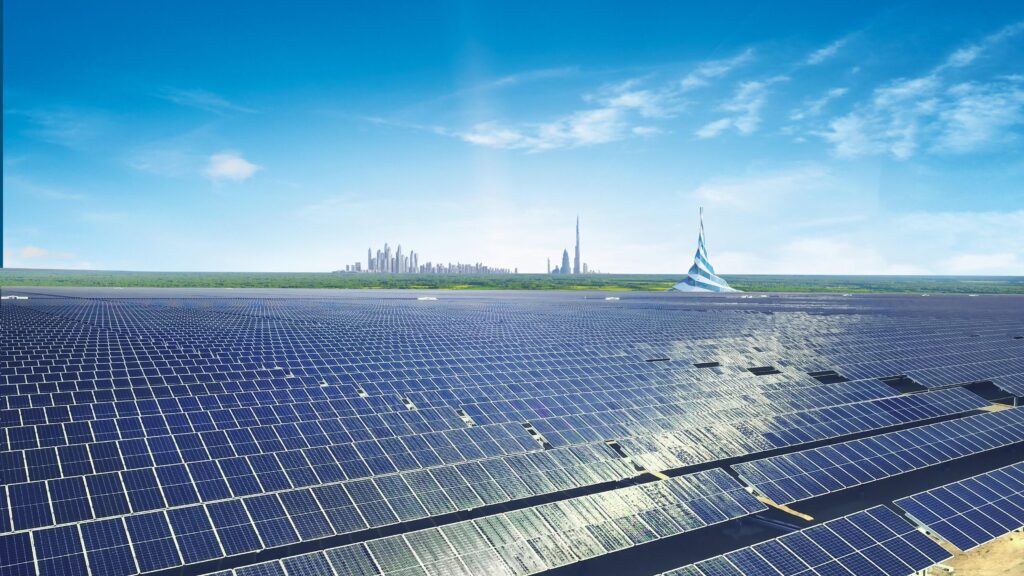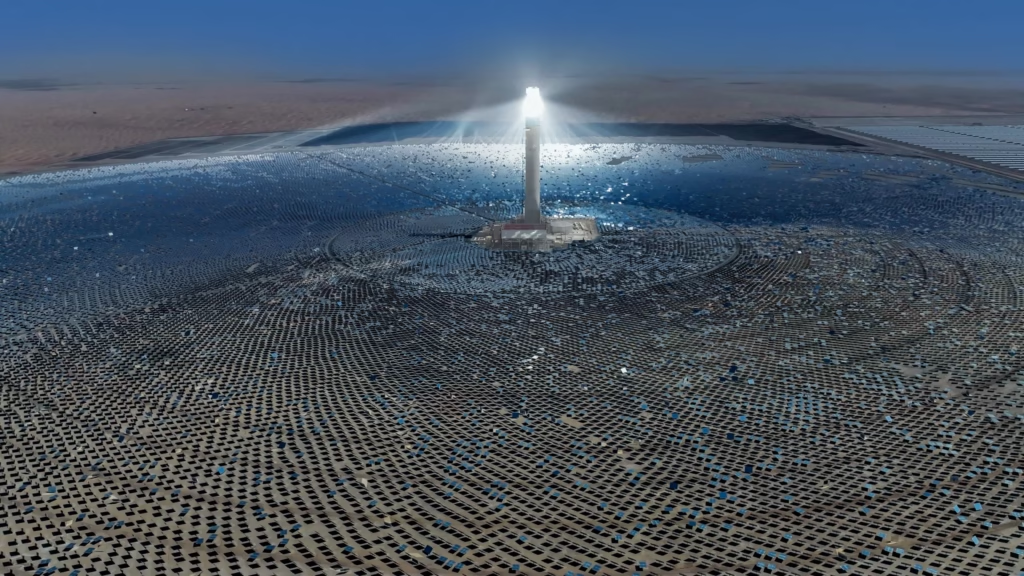The Mohammed bin Rashid Al Maktoum Solar Park is one of the most ambitious renewable energy projects in the world. Located in Seih Al-Dahal, about 50 kilometers south of Dubai, it spans a massive area and represents Dubai’s unwavering commitment to sustainable energy and environmental responsibility. When completed, it is expected to become the largest single-site solar energy facility globally.
This solar park is more than just a power generation facility. It symbolizes a forward-thinking approach to energy management and demonstrates how cities in arid regions can transform vast deserts into energy hubs. With Dubai targeting net-zero emissions by 2050, the solar park plays a crucial role in this vision.
Project Overview
The project was initiated in 2012 by the Dubai Electricity and Water Authority (DEWA). Covering over 77 square kilometers, the park combines photovoltaic technology with concentrated solar power, allowing for a hybrid approach that maximizes energy efficiency.

The park is being developed in multiple phases. Each phase builds on the previous one, integrating the latest technology and optimizing energy production. By the time all phases are complete in 2030, the solar park will have a capacity of 7,260 megawatts. To put this into perspective, this is enough electricity to power millions of homes and dramatically reduce carbon emissions.
Phases of Development
Phase 1: The Beginning
The journey of the solar park began with Phase 1, which had a capacity of 13 MW. Commissioned on October 22, 2013, it marked the start of Dubai’s transformation into a renewable energy powerhouse. Phase 1 demonstrated that solar energy could thrive even in desert conditions with high temperatures and low humidity.
Phase 2: Scaling Up
Phase 2, launched in 2017, increased the park’s capacity to 200 MW. It used over 2.3 million photovoltaic panels and achieved a record-low energy tariff, making solar energy even more competitive. This phase proved that large-scale solar projects could provide cost-effective electricity without compromising reliability or efficiency.
Phase 3: Expanding Horizons
By 2020, Phase 3 added 800 MW to the park through the installation of more than 3 million photovoltaic panels. This expansion made a tangible impact on Dubai’s energy mix, supplying electricity to roughly 240,000 homes. Importantly, this phase also helped reduce 1.4 million tonnes of CO₂ emissions annually, demonstrating the project’s environmental benefits.
Phase 4: Hybrid Innovation
Phase 4, known as Noor Energy 1, became operational in December 2023. It introduced a hybrid system combining concentrated solar power and photovoltaic technologies. Notably, it features the world’s tallest solar power tower, standing 262.44 meters high, and has a capacity of 950 MW. This innovative phase allows energy storage, meaning electricity can be generated even when the sun isn’t shining. Phase 4 alone is expected to prevent 1.6 million tonnes of CO₂ emissions each year.
Phase 5: Achieving Milestones
Phase 5, completed in June 2023, has a capacity of 900 MW. It broke records for the lowest electricity bid price for solar energy globally. The phase will provide clean electricity to approximately 270,000 homes, highlighting how large-scale solar projects can directly improve the lives of citizens while reducing environmental impact.
Phase 6: Future Prospects
Phase 6 is currently under development and is expected to add 1,800 MW using advanced photovoltaic technology. Scheduled for completion between 2024 and 2026, this phase will significantly reduce Dubai’s carbon footprint by an estimated 2.36 million tonnes of CO₂ annually. Once completed, the solar park will truly represent a landmark achievement in renewable energy.
Technological Innovations
The Mohammed bin Rashid Al Maktoum Solar Park is a showcase of advanced energy technology. Some key innovations include:
- Hybrid photovoltaic and concentrated solar power systems allow energy to be stored and used even when sunlight is not available.
- Advanced solar tracking allows panels to adjust to follow the sun’s movement, capturing maximum energy throughout the day.
- Desert-specific engineering ensures solar equipment can withstand extreme heat, sandstorms, and dust, ensuring continuous operation.
- Energy storage solutions include molten salt storage, allowing electricity production for several hours after sunset.
These innovations make the solar park not only one of the largest but also one of the most advanced solar projects in the world.
Environmental Impact
The environmental benefits of the solar park are immense:
- Reduction of 6.5 million tonnes of CO₂ emissions annually once fully operational.
- Conservation of natural resources by decreasing reliance on fossil fuels.
- Promotion of sustainable development and clean energy adoption in the region.
Beyond numbers, the solar park sets a standard for sustainable urban planning. It transforms desert land into a productive energy resource while reducing greenhouse gas emissions on a massive scale.
Economic and Social Impact
The solar park has also had a significant economic and social impact:
- Job creation has been significant, providing employment in construction, operation, and maintenance of the solar park.
- Investment attraction has drawn global investors and renewable energy companies to Dubai.
- Energy cost reduction benefits residents and businesses with lower electricity prices.
- Innovation and education opportunities arise from the park serving as a hub for renewable energy research and training.
By combining environmental sustainability with economic benefits, the solar park represents a model for future global energy projects.

Strategic Importance
The solar park is a key component of Dubai’s long-term energy vision:
- Dubai Clean Energy Strategy 2050 aims to supply 75 percent of Dubai’s energy from clean sources by 2050.
- Net Zero Emissions Strategy 2050 focuses on reducing the city’s carbon footprint and achieving a sustainable energy future.
- Global leadership ensures Dubai is recognized as a leader in renewable energy innovation.
This strategic importance goes beyond energy production. It emphasizes Dubai’s commitment to sustainability, economic growth, and international collaboration in the fight against climate change.
Global Recognition
The project has attracted worldwide attention for its scale, innovation, and environmental benefits. It serves as an inspiration for other countries and cities seeking to develop large-scale renewable energy solutions in challenging environments. By combining technology, sustainability, and ambitious goals, the Mohammed bin Rashid Al Maktoum Solar Park has set a global benchmark for solar energy development.
Future Outlook
The solar park continues to expand and innovate. With new phases coming online, energy storage technology improving, and solar panel efficiency increasing, Dubai is on track to meet and possibly exceed its renewable energy targets.
As countries worldwide look for solutions to climate change, the solar park provides a blueprint for harnessing the sun’s energy at scale. It also demonstrates how government policy, investment, and technology can work together to achieve environmental and economic goals simultaneously.
Conclusion
The Mohammed bin Rashid Al Maktoum Solar Park is more than just a solar project. It is a symbol of Dubai’s vision for a sustainable, innovative, and resilient future. From pioneering technology and large-scale energy production to reducing carbon emissions and inspiring global action, the park is a beacon for renewable energy worldwide.
As each phase comes online, Dubai strengthens its position as a leader in clean energy while offering a real-world example of how cities can harness renewable resources for a brighter, cleaner future.
The park proves that even in desert conditions, with the right vision and technology, solar energy can power cities, create jobs, and help the world combat climate change. Its continued growth promises to inspire similar projects around the globe and solidify Dubai’s role in shaping the renewable energy landscape of the 21st century.
Do follow her on Instagram













